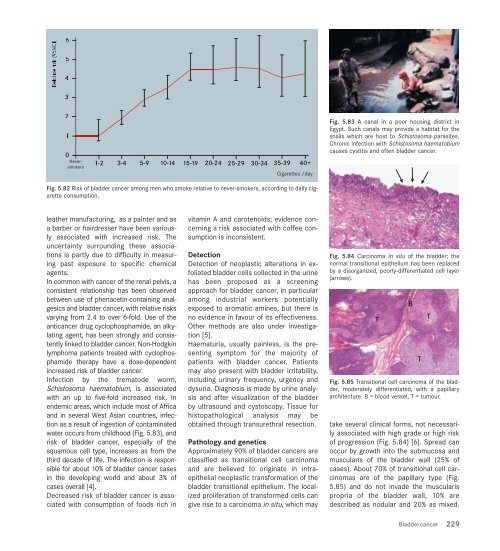world cancer report - iarc
world cancer report - iarc
world cancer report - iarc
Create successful ePaper yourself
Turn your PDF publications into a flip-book with our unique Google optimized e-Paper software.
Fig. 5.82 Risk of bladder <strong>cancer</strong> among men who smoke relative to never-smokers, according to daily cigarette<br />
consumption.<br />
leather manufacturing, as a painter and as<br />
a barber or hairdresser have been variously<br />
associated with increased risk. The<br />
uncertainty surrounding these associations<br />
is partly due to difficulty in measuring<br />
past exposure to specific chemical<br />
agents.<br />
In common with <strong>cancer</strong> of the renal pelvis, a<br />
consistent relationship has been observed<br />
between use of phenacetin-containing analgesics<br />
and bladder <strong>cancer</strong>, with relative risks<br />
varying from 2.4 to over 6-fold. Use of the<br />
anti<strong>cancer</strong> drug cyclophosphamide, an alkylating<br />
agent, has been strongly and consistently<br />
linked to bladder <strong>cancer</strong>. Non-Hodgkin<br />
lymphoma patients treated with cyclophosphamide<br />
therapy have a dose-dependent<br />
increased risk of bladder <strong>cancer</strong>.<br />
Infection by the trematode worm,<br />
Schistosoma haematobium, is associated<br />
with an up to five-fold increased risk. In<br />
endemic areas, which include most of Africa<br />
and in several West Asian countries, infection<br />
as a result of ingestion of contaminated<br />
water occurs from childhood (Fig. 5.83), and<br />
risk of bladder <strong>cancer</strong>, especially of the<br />
squamous cell type, increases as from the<br />
third decade of life. The infection is responsible<br />
for about 10% of bladder <strong>cancer</strong> cases<br />
in the developing <strong>world</strong> and about 3% of<br />
cases overall [4].<br />
Decreased risk of bladder <strong>cancer</strong> is associated<br />
with consumption of foods rich in<br />
vitamin A and carotenoids; evidence concerning<br />
a risk associated with coffee consumption<br />
is inconsistent.<br />
Detection<br />
Detection of neoplastic alterations in exfoliated<br />
bladder cells collected in the urine<br />
has been proposed as a screening<br />
approach for bladder <strong>cancer</strong>, in particular<br />
among industrial workers potentially<br />
exposed to aromatic amines, but there is<br />
no evidence in favour of its effectiveness.<br />
Other methods are also under investigation<br />
[5].<br />
Haematuria, usually painless, is the presenting<br />
symptom for the majority of<br />
patients with bladder <strong>cancer</strong>. Patients<br />
may also present with bladder irritability,<br />
including urinary frequency, urgency and<br />
dysuria. Diagnosis is made by urine analysis<br />
and after visualization of the bladder<br />
by ultrasound and cystoscopy. Tissue for<br />
histopathological analysis may be<br />
obtained through transurethral resection.<br />
Pathology and genetics<br />
Approximately 90% of bladder <strong>cancer</strong>s are<br />
classified as transitional cell carcinoma<br />
and are believed to originate in intraepithelial<br />
neoplastic transformation of the<br />
bladder transitional epithelium. The localized<br />
proliferation of transformed cells can<br />
give rise to a carcinoma in situ, which may<br />
Fig. 5.83 A canal in a poor housing district in<br />
Egypt. Such canals may provide a habitat for the<br />
snails which are host to Schistosoma parasites.<br />
Chronic infection with Schistosoma haematobium<br />
causes cystitis and often bladder <strong>cancer</strong>.<br />
Fig. 5.84 Carcinoma in situ of the bladder; the<br />
normal transitional epithelium has been replaced<br />
by a disorganized, poorly-differentiated cell layer<br />
(arrows).<br />
T<br />
Fig. 5.85 Transitional cell carcinoma of the bladder,<br />
moderately differentiated, with a papillary<br />
architecture. B = blood vessel, T = tumour.<br />
take several clinical forms, not necessarily<br />
associated with high grade or high risk<br />
of progression (Fig. 5.84) [6]. Spread can<br />
occur by growth into the submucosa and<br />
muscularis of the bladder wall (25% of<br />
cases). About 70% of transitional cell carcinomas<br />
are of the papillary type (Fig.<br />
5.85) and do not invade the muscularis<br />
propria of the bladder wall, 10% are<br />
described as nodular and 20% as mixed.<br />
B<br />
T<br />
T<br />
Bladder <strong>cancer</strong><br />
229

















